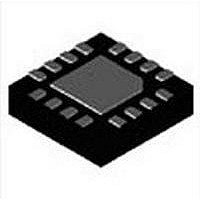MAX17149ETE+ Maxim Integrated Products, MAX17149ETE+ Datasheet - Page 17

MAX17149ETE+
Manufacturer Part Number
MAX17149ETE+
Description
LED Drivers 6-String WLED Driver
Manufacturer
Maxim Integrated Products
Datasheet
1.MAX17129ETE.pdf
(20 pages)
Specifications of MAX17149ETE+
Operating Supply Voltage
3 V to 26 V
Maximum Supply Current
4 mA
Maximum Power Dissipation
1176 mW
Maximum Operating Temperature
+ 85 C
Mounting Style
SMD/SMT
Package / Case
TQFN-16
Minimum Operating Temperature
- 40 C
Lead Free Status / RoHS Status
Lead free / RoHS Compliant
The total output-voltage ripple has two components: the
capacitive ripple caused by the charging and discharging
on the output capacitor, and the ohmic ripple due to the
capacitor’s equivalent series resistance (ESR):
and:
where I
Inductor Selection section).
The output-voltage ripple voltage should be low enough
for the FB_ current-source regulation. The ripple voltage
should be less than 200mV
tors, the output-voltage ripple is typically dominated by
V
teristics of the output capacitor must also be considered.
The devices’ high switching frequency demands a high-
speed rectifier. Schottky diodes are recommended for
most applications because of their fast recovery time
and low forward voltage. The diode should be rated to
handle the output voltage and the peak switch current.
Make sure that the diode’s peak current rating is at least
I
that its breakdown voltage exceeds the output voltage.
The input capacitor (C
from the input supply and reduces noise injection into
the ICs. A 4.7FF ceramic capacitor is used in the Typical
Operating Circuit (Figure 1) because of the high source
impedance seen in typical lab setups. Actual applica-
tions usually have much lower source impedance since
the step-up regulator often runs directly from the output
of another regulated supply. In some applications, C
can be reduced below the values used in the Typical
Operating Circuit. Ensure a low-noise supply at IN by
using adequate C
tion can be tolerated on C
using an RC lowpass filter.
The series/parallel configuration of the LED load and the
full-scale bias current has a significant effect or regula-
tor performance. LED characteristics vary significantly
PEAK
RIPPLE(C)
V
RIPPLE(C)
calculated in the Inductor Selection section and
PEAK
V
V
RIPPLE
. The voltage rating and temperature charac-
RIPPLE(ESR)
is the peak inductor current (see the
≈
I
= V
OUT(MAX)
IN
C
. Alternatively, greater voltage varia-
Output Capacitor Selection
OUT
RIPPLE(C)
IN
Input Capacitor Selection
≈ I
Rectifier Diode Selection
) filters the current peaks drawn
Low-Cost, 6-String WLED Drivers with
IN
PEAK
LED Selection and Bias
if IN is decoupled from C
V
P-P
OUT(MAX)
V
+ V
x R
OUT(MAX)
. For ceramic capaci-
RIPPLE(ESR)
ESR(COUT)
−
Quick-PWM Step-Up Converter
V
×
IN(MIN)
f
SW
IN
IN
from manufacturer to manufacturer. Consult the respec-
tive LED data sheets to determine the range of output
voltages for a given brightness and LED current. In
general, brightness increases as a function of bias cur-
rent. This suggests that the number of LEDs could be
decreased if higher bias current is chosen; however, a
high current increases LED temperature and reduces
operating life. Improvements in LED technology are
resulting in devices with lower forward voltage while
increasing the bias current and light output.
LED manufacturers specify the LED color at a given LED
current. With lower LED current, the color of the emitted
light tends to shift toward the blue range of the spectrum.
A blue bias is often acceptable for business applications
but not for high-image-quality applications such as DVD
players. DPWM dimming is a viable solution for reducing
power dissipation while maintaining LED color integrity.
Careful attention should be paid to switching noise to
avoid other display quality problems.
Using fewer LEDs in a string improves step-up converter
efficiency, and lowers breakdown voltage requirements
of the external MOSFET and diode. The minimum num-
ber of LEDs in series should always be greater than max-
imum input voltage. If the diode voltage drop is lower
than maximum input voltage, the voltage drop across the
current-sense inputs (FB_) increases and causes excess
heating in the IC. Between 8 and 12 LEDs in series are
ideal for input voltages up to 20V.
The forward voltage of each white LED may vary up to
25% from part to part and the accumulated voltage dif-
ference in each string equates to additional power loss
within the devices. For the best efficiency, the voltage
difference between strings should be minimized. The
difference between lowest voltage string and highest
voltage string should be less than 8V (typ). Otherwise,
the internal LED short-protection circuit disables the high
FB voltage string.
The current through each FB_ pin is controlled only during
the step-up converter’s on-time. During the converter off-
time the current sources are turned off. The output voltage
does not discharge and stays high. The devices disable
the FB current source, which string shorts. In this case,
the step-up converter’s output voltage is always applied
to the disabled FB pin. FB_ pin can withstand 48V.
Applications Information
FB Pin Maximum Voltage
LED V
FB_
Variation
17











